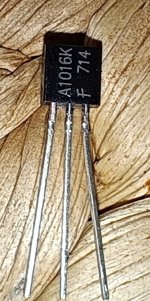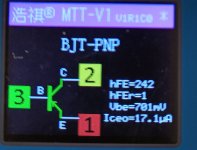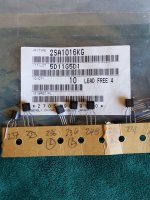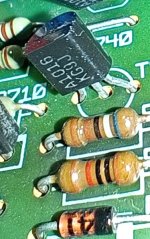That pretty much leaves you with NOS (new old stock) transistors, as the manufacturers have transitioned to TO-247 or TO-3P packages with rectangular outlines. You will have to be very careful buying those older devices so as to not end up with a bunch of fake transistors yet again. If you are successful in finding some of the older devices that are not fake, you will need to invest in some TO-3 insulating bushings for the collector tab to insulate the mounting screw from the heat sink. I would suggest making contact to the collector with a lead coming up through the second unused mounting hole and soldered to the center collector lead on the transistor, which you can clip shorter for convenience. Actually, that particular package type you show in the picture was expressly designed long ago by Texas Instruments to sub for a TO-3 metal package, and should fit inside the TO-3 outline.
It still looks to me like the placement of the TO-3 transistors is offset on the heat sink, so that there is more space on one side of the transistors than the other, so it may be just possible to mount a TO-3P package instead of the TO-3. I would suggest getting your hands on a sample TO3-P device, popping out one of the TO-3 packages, and doing a fit test.
It still looks to me like the placement of the TO-3 transistors is offset on the heat sink, so that there is more space on one side of the transistors than the other, so it may be just possible to mount a TO-3P package instead of the TO-3. I would suggest getting your hands on a sample TO3-P device, popping out one of the TO-3 packages, and doing a fit test.
Last edited:
You will unfortunately NOT find any high fT PNPs in the TO-218. Might find some old switchmode NPNs. BD249/250 don’t count - they are essentially TIPs. Spec windows are tighter, but it‘s just polishing a turd.
Those sockets are offset to one side - but if I’m looking at it correctly it is offset to the WRONG side to give clearance enough for a TO-247. Maybe there is enough - you could try and see. Plenty of ways and space to mount it on the flip side, however.
I have heard of people using MJE1503x TO-220 drivers in their Phase Linears. Mounted on the inside, of course. They CAN drive three MJ15003’s (which is essentially what the Fairchild PL909 was).
Those sockets are offset to one side - but if I’m looking at it correctly it is offset to the WRONG side to give clearance enough for a TO-247. Maybe there is enough - you could try and see. Plenty of ways and space to mount it on the flip side, however.
I have heard of people using MJE1503x TO-220 drivers in their Phase Linears. Mounted on the inside, of course. They CAN drive three MJ15003’s (which is essentially what the Fairchild PL909 was).
How do you figure that? There are fins on both sides of the heat sink, with what looks to be the same amount of space on either side, though I guess you could just mount the plastic parts oriented straight up and down from one of the two mounting holes and bend the pins up... Lotsa rewiring, though.
It should be possible to replace the heat sinks, and TO-220 are certainly smaller than TO-3 packages.
Or simply mill away the heat sink, no need to think of TO-3 any more, just machine them to suit the TO-220 package if no replacement for housing size can be found.
I would use one mounting hole of the TO-3 to hold the TO-220 on the heat sink, and maybe longer wires from the circuit, and the legs can be bent, TDA chip amp style, for safety.
If a member is handy with a CAD program, it can be checked quickly before starting the actual job.
Or simply mill away the heat sink, no need to think of TO-3 any more, just machine them to suit the TO-220 package if no replacement for housing size can be found.
I would use one mounting hole of the TO-3 to hold the TO-220 on the heat sink, and maybe longer wires from the circuit, and the legs can be bent, TDA chip amp style, for safety.
If a member is handy with a CAD program, it can be checked quickly before starting the actual job.
TO-220 packages will not have anywhere the dissipation capability of a TO-3, TO-3P, or a TO-247. A bunch would be needed in parallel operation to get near the SOA capability of the original design. This is likely way more than this guy would be willing to do. If you are going as far as to mill the heat sink there will be plenty of room for TO-3P devices anyway.
The two collector holes are not equi-distant from the fins. The one you NEED to drop in a TO-3P directly is the one that’s too close. The only way to use the other is from the back, with “lotsa rewiring”.How do you figure that? There are fins on both sides of the heat sink, with what looks to be the same amount of space on either side, though I guess you could just mount the plastic parts oriented straight up and down from one of the two mounting holes and bend the pins up... Lotsa rewiring, though.
The driver doesn’t NEED 200 watts of dissipation capability. 600 watts divided by a beta of only 20 is 30 watts. Too much for a typical Jap driver, but the MJEs are used all the time to drive banks of up to 6 flatpacks in QSC amps. Not as much margin, but it’s not like it just won’t work.
TO-3 is 15.4 x 39 mm, mounting holes center is 30.2 mm (typical).
TO-3P is 20 mm long x 15.5 wide, it should fit in place, some wiring skill is needed.
I think it can be done, but I bow to your experience.
Like wg_ski above says, the actual holes may not match, so drilling time?
Edit: How about making the emitter / base hole larger, and using that to mount the transistor, use the old mounting holes to pass wires? Might work...only one is needed, the one closer to center may be used.
TO-3P is 20 mm long x 15.5 wide, it should fit in place, some wiring skill is needed.
I think it can be done, but I bow to your experience.
Like wg_ski above says, the actual holes may not match, so drilling time?
Edit: How about making the emitter / base hole larger, and using that to mount the transistor, use the old mounting holes to pass wires? Might work...only one is needed, the one closer to center may be used.
Last edited:
I begin to understand now - I thought this guy was trying to replace outputs with faster devices, but it's really about drivers... TO3s as drivers? what kinda design is this? Oh, I just looked at the topside with a little more magnification, and it's a McIntosh... Oh, well
This may be the wrong thread, but two members from Buenos Aires - J M Fahey and Osvaldo de Bansfield - have not posted since 20 February.
If any information is available, please PM, or post publicly.
If any information is available, please PM, or post publicly.
Perhaps I did not make clear before - indeed, I want to replace only driver transistor, not output transistors. Outputs are fine. In picture that I posted current driver is MJ15025, which should be replaced. Yes, they are two old McIntosh amplifiers which used TO3 for driver and TO3 for output transistors.
I have posted BD249 just for picture of it's housing and rounded metal tab instead of square ones. I know that BD249 itself is not good replacement for driver.
As TO3 is not available I must take TO218 or TO3P or similar housing and see will it fit in any way.
Can you please recommend replacement for MJ15018/19/20/21 in flat type housing.
So far these have been mentioned:
2SC5200/2SA1943
2SA1386/2SC3519
2SA1962OTU/2SC5242OTU
Do you have any more replacements to suggest? Some of above mentioned are not available easily to me.
Thank you all
Ivo
I have posted BD249 just for picture of it's housing and rounded metal tab instead of square ones. I know that BD249 itself is not good replacement for driver.
As TO3 is not available I must take TO218 or TO3P or similar housing and see will it fit in any way.
Can you please recommend replacement for MJ15018/19/20/21 in flat type housing.
So far these have been mentioned:
2SC5200/2SA1943
2SA1386/2SC3519
2SA1962OTU/2SC5242OTU
Do you have any more replacements to suggest? Some of above mentioned are not available easily to me.
Thank you all
Ivo
NJW0281/0302 or 3281/1302 - ON Semi versions - any “Toshiba” sold today will be fake
MJW versions are TO-247 which is the same size, MJL versions are larger TO-264
B817/D1047
C5200N/A1943N (‘N’ versions are TO-3P, non suffix version is larger TO-264).
MJW versions are TO-247 which is the same size, MJL versions are larger TO-264
B817/D1047
C5200N/A1943N (‘N’ versions are TO-3P, non suffix version is larger TO-264).
I made a couple of suggestions for faster alternate devices back in post #1516. Both sets of complementary devices are in the TO-3P package. They are available from Digi-Key, which may or may not be a viable option for South of the border...
Fairchild would call the part a KSA1016K. However, that does not really look like a legit Fairchild logo on the package - it looks "off".
The 2SA1016K originally was originally made by Sanyo. I can't find any reference to a Fairchild knockoff of the device. The "F" might refer to the lowest beta range, which is listed in the original Sanyo datasheet. However, you would think that an "F" designation would have been done in plain script. Instead, it kinda looks like a lame attempt to copy the Fairchild logo.
Edit - Onsemi actually at one time made this device as a 2SA part. When I checked with Digi-Key, they listed it as a "marketplace" device, meaning that it is out of production and that there is stock with a broker somewhere.
Edit - Onsemi actually at one time made this device as a 2SA part. When I checked with Digi-Key, they listed it as a "marketplace" device, meaning that it is out of production and that there is stock with a broker somewhere.
Thank you all for your advices about my TO3 driver transistors. I will try to find some of recemmended substitutes.
Ivo
Ivo
Ok, thanks guys for 2SA1016K. Anyway I reralized that I need G grading and those regardles of if they are original, from mesurements fall into F grading.
Guys, I recently built a nice curve tracer, and I somehow just like playing with it. It can do power transistors, small transistors, tubes, whatever... Sooo, if you need / want your parts tested, send me a PM.
- Home
- Design & Build
- Parts
- My Transistors, original or copy?



